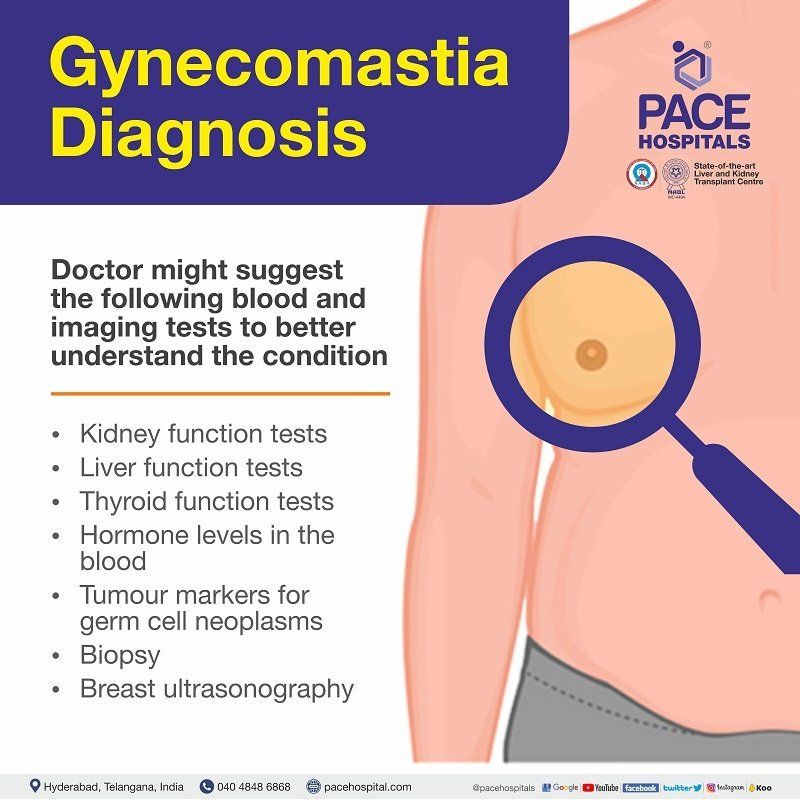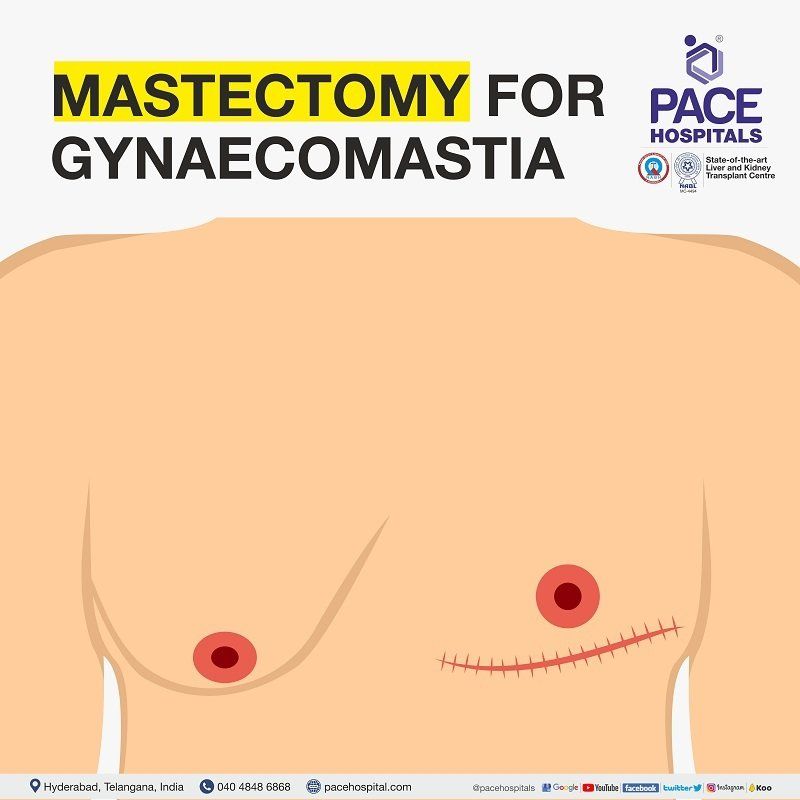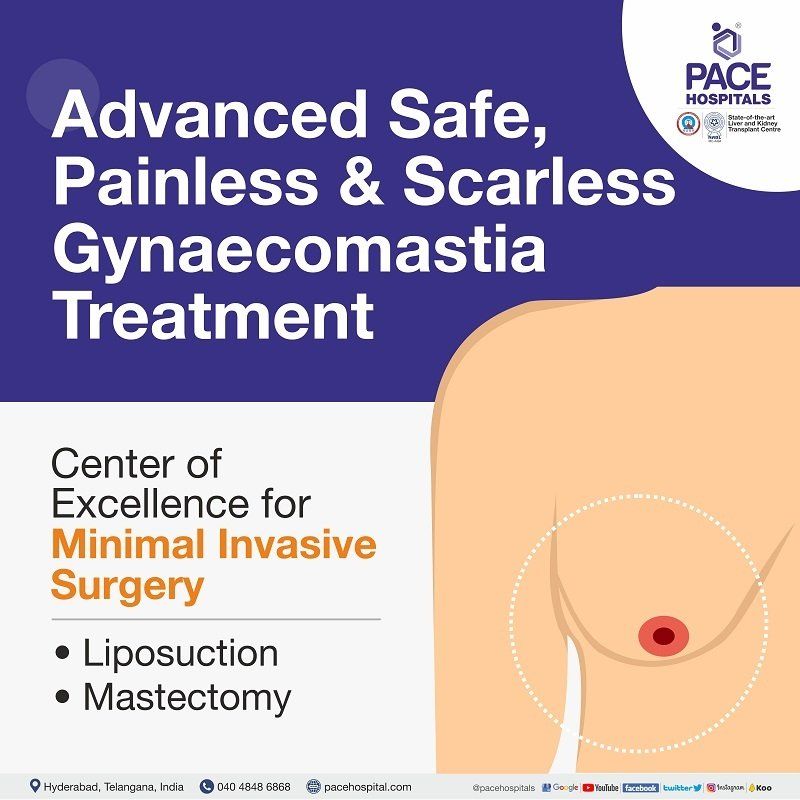Gynecomastia Treatment in Hyderabad, Surgery and Cost
At PACE Hospitals, team of gynecomastia doctors – highly qualified and experienced plastic and reconstructive surgeon, aesthetic surgeon are experienced in performing aesthetic plastic surgery, male breast reduction surgery for gynecomastia. The treatment options available are:
- Liposuction (male breast fat tissue removal)
- Mastectomy (male glandular breast tissue removal)
Get Rid of Gynecomastia, Request an appointment.
Gynaecomastia Treatment - appointment
Thank you for contacting us. We will get back to you as soon as possible. Kindly save these contact details in your contacts to receive calls and messages:-
Appointment Desk: 04048486868
Whatsapp: 7842171717
Regards,
Pace Hospitals
Hitech City and Madinaguda
Hyderabad, Telangana, India.
Thank you for contacting us. We will get back to you as soon as possible. Kindly save these contact details in your contacts to receive calls and messages:-
Appointment Desk: 04048486868
Whatsapp: 7842171717
Regards,
Pace Hospitals
Hitech City and Madinaguda
Hyderabad, Telangana, India.
Diagnosis of Gynecomastia
The diagnosis of gynaecomastia is primarily based on physical examination (symptoms). You will be in a supine (lying) position, where your doctor will examine you for firmness (presence of glandular mass) by performing a gynecomastia pinch test (squeezing the breast between the examiner's thumb and forefinger) on the area starting from the outer regions of the breast to the centre (nipple).

During a physical exam, gynaecomastia is diagnosed when the area under the areolar (coloured area around the nipple) breast tissue is 2 cm or bigger. Further, your doctor might suggest the following blood and imaging tests to better understand the condition.
Kidney function tests: This test is used to assess how efficiently your kidneys are working (removing waste from your body). Blood and urine sample are required for this test. Any abnormality in this test might indicate the underlying condition of gynaecomastia.
Liver function tests: This test is used to measure various enzymes and proteins of the liver through a blood sample. It includes albumin, total protein, alkaline phosphatase, alanine transaminase, aspartate aminotransferase, gamma-glutamyl transferase, bilirubin, prothrombin time and lactate dehydrogenase. Your doctor might suggest this test to check for any liver abnormalities. If you have liver disease, you will have an:
- Increase in androstenedione production from the adrenal glands,
- Increase in the conversion of androstenedione to oestrone and oestrone to oestradiol.
- Decrease in the clearance of adrenal androgens from the liver.
- Increase in sex hormone binding globulin.
These factors result in a decrease in free testosterone levels in the blood. This causes an imbalance between oestradiol and testosterone concentration, which is one of the reasons for the gynaecomastia condition.
Thyroid function tests: This test is used to measure thyroid (T3 and T4) hormone, T3 resin uptake, and thyroid stimulating hormone levels in the blood. The increase in T4 and T3 levels and low thyroid stimulating hormone leads to hyperthyroidism.
Due to the presence of hyperthyroidism, there will be an increase in blood luteinizing hormone concentration, which leads to an increase in oestradiol levels and testosterone production from Leydig cells (primary source of testosterone or androgens in males). In addition to this, sex hormone binding globulin will be increased. As a result, it will increase the oestradiol concentration, which causes the imbalance between the oestradiol and testosterone concertation.
Hormone levels in the blood:
- Serum levels of testosterone hormone (total and bioavailable), luteinizing hormone, follicle-stimulating hormone and prolactin hormone. Abnormal concentrations of these hormones might result in a decrease in testosterone levels.
- Oestrogen (oestradiol) hormone levels in the blood: An increase in oestrogen concentration can result in an imbalance between oestradiol and testosterone concertation, which is the primary cause of gynaecomastia.
- Levels of adrenal androgens: An increase in adrenal androgens like serum dehydroepiandrosterone sulphate leads to an increase in oestradiol concentration. This causes an imbalance between oestradiol and testosterone concentration, which is the root cause of gynaecomastia.
Tumour markers for germ cell neoplasms: The presence of tumour markers such as beta human chorionic gonadotropin suggests the presence of germ cell neoplasm, which can be used to diagnose testicular cancer. Men with testicular cancer have low testosterone levels.
Biopsy: a procedure where a small amount of breast tissue is taken and examined for the presence of cancer cells. This test is conducted in order to differentiate whether you have gynaecomastia or breast cancer.
Mammogram: A low-dose X-ray of your breast, called a mammogram, may be done to check for the presence of dense breast tissue with dendritic and nodular features. The presence of such a mass diagnosis the condition of gynaecomastia.
Breast ultrasonography:
This test is done in order to access the presence of hypoechoic mass (a tissue which is more dense or solid than usual) under the areolar region (the region of dark-coloured skin that surrounds the nipple). The presence of such a mass signifies the presence of gynaecomastia.
Advanced Centre for Gynecomastia Surgery with State-of-the-art Laser Technology
PACE Hospitals is one of the Advanced and Experienced Gynecomastia Treatment Hospital in Hyderabad backed up with the best plastic and reconstructive surgery doctors, aesthetic surgery doctors, nursing, and paramedical staff. Department of Plastic and Reconstructive Surgery, Cosmetic Surgery at Pace Hospitals equipped with state-of-the-art facility and latest laser ablation technology offering comprehensive treatment for breast enlargement in men.
Gynecomastia stages
The degree of skin excess and ptosis determines the specific course of treatment for types, grades and stages of Gynecomastia (male breast enlargement).
As per the Simon et al, according to the degree of breast enlargement, the amount of skin excess, gynecomastia (male breast development) is categorised into three grades.
- Grade I: Small enlargement without skin excess
- Grade IIa: Moderate enlargement without skin excess
- Grade IIb: Moderate enlargement with minor skin excess
- Grade III: Marked enlargement with excess skin, mimicking female breast ptosis
Know more: Types, Grades and Stages of Gynecomastia
Gynecomastia treatment
Gynaecomastia or male breast enlargement usually resolves on its own over time. Some cases of gynaecomastia do not require treatment:
- If it occurs during puberty (boy boobs appears at the time when adolescents reach sexual maturity and are capable of reproducing), it usually resolves within six months to two years.
- If it is caused by the use of certain medications, your doctor may advise you to discontinue them as part of your treatment.
Enlarged male breasts treatment may be required in cases where the cause is by:
- Underlying diseases such as hypogonadism, starvation, liver cirrhosis, kidney failure, dialysis, etc. In such cases, the physician tries to treat the underlying condition.
- Increased severity of gynaecomastia (severe gynecomastia) despite no underlying diseases to treat, and if there has been no improvement in the last six months (from the date of onset), or if it causes significant pain and tenderness.
There are two types of treatment options for gynaecomastia, depending on the underlying cause such as early puberty, certain diseases and conditions (renal / kidney failure, hyperthyroidism, cirrhosis, or liver disease, overweight / obese etc.), maternal transfer and certain medications.
Medical Treatment
Based on the patients' condition, medication or hormonal therapy is advised by doctor to treat gynecomastia (male breast development) that includes:
- If the gynaecomastia is caused by any medication, it should be stopped or substituted with alternate medication by your physician.
- If the gynaecomastia is caused by a hormonal imbalance, a hormonal therapy that stimulates hormone production will be initiated.
- Testosterone replacement therapy
- Oestrogen receptor modulators
Surgical Treatment
There are two types of gynecomastia surgery or male breast reduction surgery performed based on the presence of fat and glandular breast tissue:
- Liposuction (male breast fat tissue removal)
- Mastectomy (male glandular breast tissue removal)
In a few cases, depending on the severity (gynecomastia stages) of the condition, both surgical procedures will be performed.

Liposuction (male breast fat tissue removal)
It is a surgical procedure where excess fat is removed from a specific area of the body with the help of suction. Under local or general anaesthesia (based on the patient's profile), the patient was marked at the area of incision before surgery. After anaesthesia is administered, the liposuction process will be started by making very small incisions in the targeted area. The number of incisions needed is determined by the amount of fat deposited. The surgeon inserts a thin tube called a cannula into the incision. The inserted cannula will undergo continuous back and forth in a guided movement, to dislodge the fat cells. The dislodged fat is then sucked out through a surgical vacuum. Post that, the surgeon closes the incision with absorbable sutures (stiches) and firmly bands the area. You may be asked to wear compression garment for one month. Some surgeons might use advanced techniques like ultrasound and laser to minimise invasiveness.

Mastectomy (male glandular breast tissue removal)
Mastectomy is a surgical procedure used to treat the patient when there is a requirement for the removal of glandular breast tissue or excess skin in order to correct gynaecomastia conditions. Under general anaesthesia, the excess fat and glandular tissue will be removed through an incision (above, beneath, or to the side of the nipple). The open area is then closed with sutures (stiches). You may be asked to wear compression garment for one month.
-
What exactly is gynecomastia?
Gynaecomastia is a condition in male where the breast will grow due to the accumulation of fat and non-cancerous expansion of the glandular tissue due to a hormonal imbalance between oestrogens and testosterone. It can happen on both or either side of the chest.
-
Can breast gland grow back after doing gynecomastia surgery?
There are minimal chances of reoccurrence, as the most common cause of reoccurrence is non-removal of glandular tissue completely, as a result of which the breast gland will grow back after undergoing gynaecomastia surgery / male breast reduction surgery. Hence, you required a highly qualified and vastly experienced plastic surgeon in order to avoid a reoccurrence.
-
Is gynecomastia cured by exercise?
Gynaecomastia (man boobs) can’t be cured through exercise, but it can help reduce the appearance of gynecomastia
There are primarily two types of exercises:
- Cardio exercises help burn general body fat.
- Chest exercises that help increase the size of the pectoral (breast) muscles.
-
Why do renal diseases cause gynecomastia?
Leydig cells (a source of testosterone production) function is altered in people with chronic kidney disease or those undergoing haemodialysis. So due to reduced production of testosterone, accompanied with high levels of oestrogen and luteinizing hormone, a hormonal imbalance is created which leads to gynaecomastia.
Frequently asked questions:
Why does cirrhosis cause gynaecomastia?
If you are suffering from liver cirrhosis:
- There will be an increase in the production of hormone from the adrenal glands.
- A decrease in the clearance of adrenal androgens from the liver, and increased hormone binding globulin lead to a decrease in free testosterone levels in the blood.
Thus, the decrease in testosterone levels leads to gynaecomastia (man boobs or enlarged male breast tissue).
Can testosterone cure gynaecomastia?
Yes, with the help of testosterone replacement therapy, it can be resolved. This therapy helps in maintaining testosterone and oestrogen ratios in the blood, thereby reducing gynaecomastia (male breast development) condition.
How to figure out if its gynaecomastia?
Check the area behind or surrounding the nipple (either of one or both). If you find any soft rubbery lump or if you have any pain in that particular area consult your physician immediately. If there is nothing such, then it is a pseudogynaecomastia which occurred due to excess body fat storage, otherwise your physician will be diagnosing based on physical examination, or might request for following tests for more clarity.
- Breast ultrasonography and mammography.
- Assessment of underlying conditions such as renal (kidney), thyroid and liver disease, testicular cancer, tumours of the adrenal glands or pituitary gland.
Read more: Gynecomastia Symptoms and Causes
Can carbohydrates increase gynaecomastia?
No, carbohydrates are essential sources for testosterone production, which could help in the maintenance of the testosterone to oestrogen concentration ratio through which gynaecomastia can be prevented.
Does ADHD treatment cause gynaecomastia?
The use of drugs is a significant contributor to the development of gynecomastia. Certain drugs like centrally acting sympathomimetic which are commonly preferred for treating attention deficit hyperactivity disorder (ADHD) in children and adolescents might have gynaecomastia as uncommon side effect.
How long to see final result of gynaecomastia surgery?
You can see the results immediately post-surgery. The incision marks which appear during the surgery will be fading out in a while and the final results may take 3-6 months to achieve.
Can we delay surgery for gynaecomastia?
In most cases, gynaecomastia in males resolves on its own and doesn’t require any surgery. However, delay in surgery for gynaecomastia could result in minimal risk of developing male breast cancer.
How long should I wear compression garment after gynaecomastia surgery?
The compression garment should be worn all day for four to six weeks, even when you sleep (can remove while on bath) to have a better outcome. It acts as a layer to protect your healing incision. It improves circulation and reduces pain.
How to Get rid of Gynaecomastia Naturally?
In general, gynaecomastia does not require any treatment as it self- subsides within in a period of time (6 months to 2 years). Stopping certain medications which cause gynaecomastia, can also help in resolving the gynaecomastia condition.
It might require treatment if it is caused by any underlying diseases such as hypogonadism, starvation, liver cirrhosis, etc and hormonal imbalance.
How much does a gynaecomastia surgery cost?
The average cost of gynaecomastia surgery in India is approximately 72,000 (Rupees seventy-two thousand only). However, male breast reduction surgery or gynaecomastia surgery cost in India, ranges vary from Rs. 62,000 to Rs. 1,36,500 (Rupees sixty-two thousand to one lakh thirty-six thousand five hundred) depends on severity or grade of male breast enlargement, the different private hospitals in different cities.
What is gynecomastia surgery cost in Hyderabad?
Gynecomastia surgery cost in Hyderabad ranges vary from Rs. 45,000 to Rs. 1,25,000 (Rupees forty-five thousand to one lakh twenty-five thousands). However, cost of gynecomastia surgery or male breast reduction surgery depends upon the multiple factors such as grade and severity of enlarged male breasts, the amount of fat to be removed, techniques such as liposuction or mastectomy performed, risk associated with the surgery, room selection for hospital stay, corporate or insurance approvals for cashless facility.

Our Locations
Subscribe to our newsletter and stay updated with the latest health information.
By clicking on subscribe now, you accept to receive communications from PACE Hospitals on email, SMS and Whatsapp.
Subscribe to PACE Hospitals News
Thank you for subscribing. Stay updated with the latest health information.
Oops, there was an error. Please try again submitting your details.
-

Payment in advance for treatment (Pay in Indian Rupees)
For Bank Transfer:-
Bank Name: HDFC
Company Name: Pace Hospitals
A/c No.50200028705218
IFSC Code: HDFC0000545
Bank Name: STATE BANK OF INDIA
Company Name: Pace Hospitals
A/c No.62206858997
IFSC Code: SBIN0020299
Scan QR Code by Any Payment App (GPay, Paytm, Phonepe, BHIM, Bank Apps, Amazon, Airtel, Truecaller, Idea, Whatsapp etc)
Call us at 04048486868
ADDRESS
PACE Hospitals
Hitech City : Beside Avasa Hotel, Pillar No. 18, Hyderabad - 500081
Madinaguda: Mythri Nagar, Beside South India Shopping, Madinaguda, Hyderabad - 500050
QUICK LINKS
Disclaimer
General information on healthcare issues is made available by PACE Hospitals through this website (www.pacehospital.com), as well as its other websites and branded social media pages. The text, videos, illustrations, photographs, quoted information, and other materials found on these websites (here by collectively referred to as "Content") are offered for informational purposes only and is neither exhaustive nor complete. Prior to forming a decision in regard to your health, consult your doctor or any another healthcare professional. PACE Hospitals does not have an obligation to update or modify the "Content" or to explain or resolve any inconsistencies therein.
The "Content" from the website of PACE Hospitals or from its branded social media pages might include any adult explicit "Content" which is deemed exclusively medical or health-related and not otherwise. Publishing material or making references to specific sources, such as to any particular therapies, goods, drugs, practises, doctors, nurses, other healthcare professionals, diagnoses or procedures is done purely for informational purposes and does not reflect any endorsement by PACE Hospitals as such.

